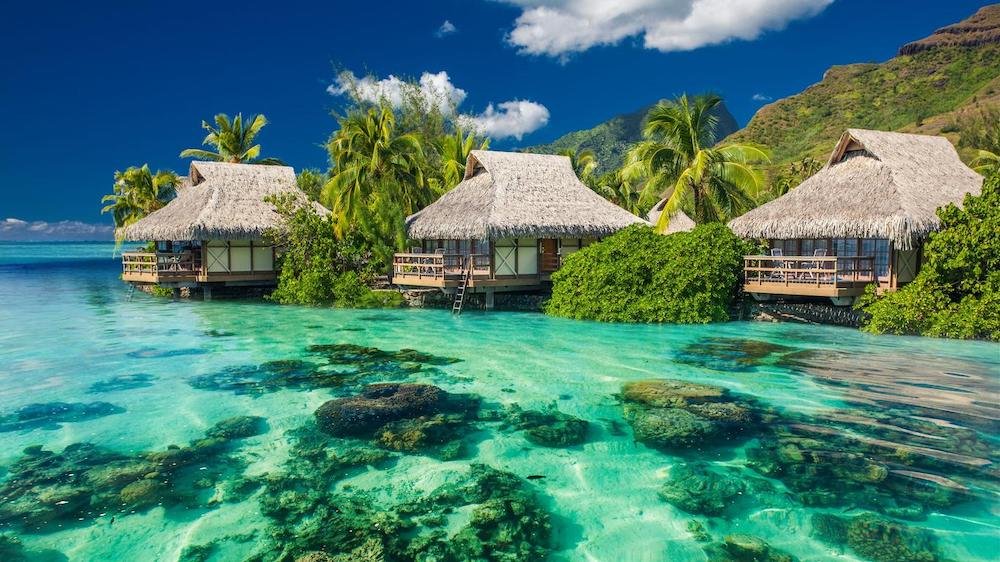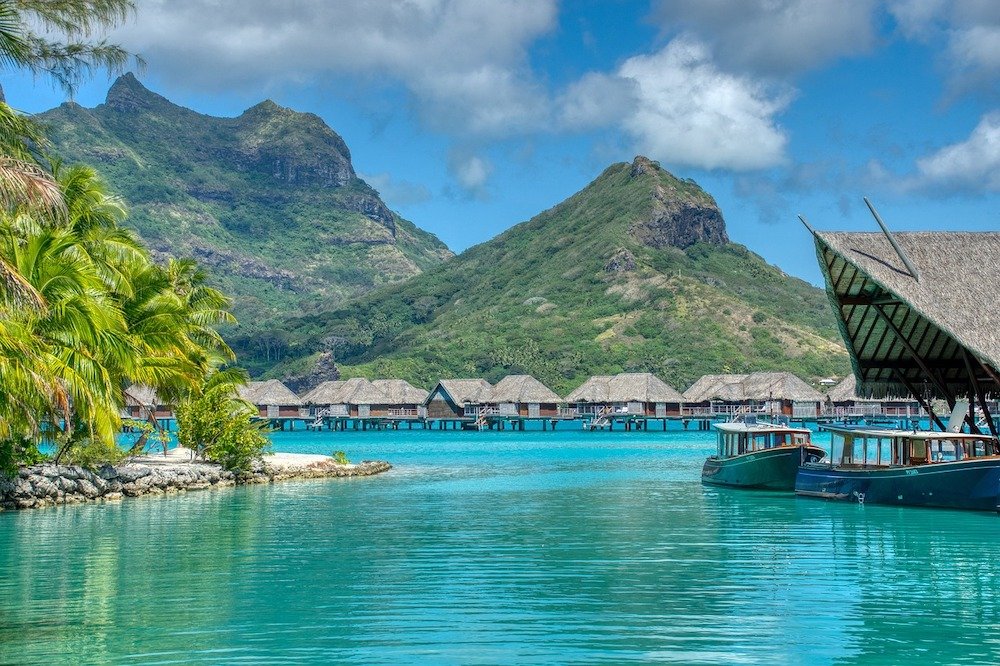
The island of Tahiti, often referred to as the “Queen of the Pacific,” is the largest island in French Polynesia, situated in the South Pacific Ocean.
Known for its breathtaking landscapes, vibrant culture, and crystal-clear waters, Tahiti is a dream destination for travelers seeking paradise.
From lush mountain peaks to pristine beaches and vibrant coral reefs, Tahiti offers a unique blend of natural beauty and cultural richness that captivates visitors from around the globe.
Preparing for a trip to Tahiti is essential to ensure a smooth and enjoyable experience.
As a remote island destination, Tahiti presents unique challenges and opportunities that travelers should be aware of before embarking on their journey.
From understanding the local customs and traditions to knowing the best time to visit and how to navigate the island’s transportation system, being prepared can greatly enhance the overall travel experience and help visitors make the most of their time in Tahiti.
In this comprehensive guide, we will delve into 14 essential things you should know before visiting the Island of Tahiti.
From practical travel tips and cultural insights to recommendations for accommodation, dining, and activities, we’ll cover everything you need to know to plan an unforgettable trip to this tropical paradise.
Whether you’re a first-time visitor or a seasoned traveler, this article will equip you with the knowledge and resources you need to make the most of your Tahitian adventure
1. Geography and Climate of Tahiti

Tahiti is situated in the South Pacific Ocean, approximately halfway between California and Australia.
It is part of the French Polynesia archipelago, which consists of 118 islands and atolls spread across an area roughly the size of Europe.
Tahiti itself is divided into two main parts: Tahiti Nui, the larger western section, and Tahiti Iti, the smaller eastern peninsula.
Tahiti’s climate throughout the year
Tahiti enjoys a tropical climate characterized by warm temperatures and high humidity year-round.
The average temperature ranges from 70°F (21°C) to 85°F (29°C), making it an ideal destination for beach lovers and outdoor enthusiasts.
The climate is influenced by the trade winds, which blow from the southeast for most of the year, bringing pleasant breezes to the island.
Tahiti experiences two distinct seasons: the wet season (November to April) and the dry season (May to October).
During the wet season, the island receives occasional heavy rainfall and tropical storms, which can result in high humidity levels and brief periods of discomfort.
However, the rain showers are typically short-lived, and the sun quickly returns to illuminate the lush landscapes of Tahiti.
Best times to visit based on weather patterns
The best time to visit Tahiti largely depends on personal preferences and travel priorities.
For travelers seeking sunny skies and minimal rainfall, the dry season (May to October) is considered the ideal time to visit. During this period, the weather is generally more predictable, with clear skies, warm temperatures, and lower humidity levels.
Alternatively, the wet season (November to April) offers its own unique charms, including lush greenery, fewer crowds, and lower accommodation rates.
While there is a higher chance of encountering rain showers and tropical storms during this time, many travelers find the occasional rainfall to be a refreshing break from the heat, and it adds to the island’s natural beauty.
Ultimately, the best time to visit Tahiti depends on individual preferences and interests.
Whether you prefer basking in the sun on pristine beaches or exploring the island’s lush rainforests and waterfalls, Tahiti offers something for everyone, regardless of the season.
2. Culture and Customs
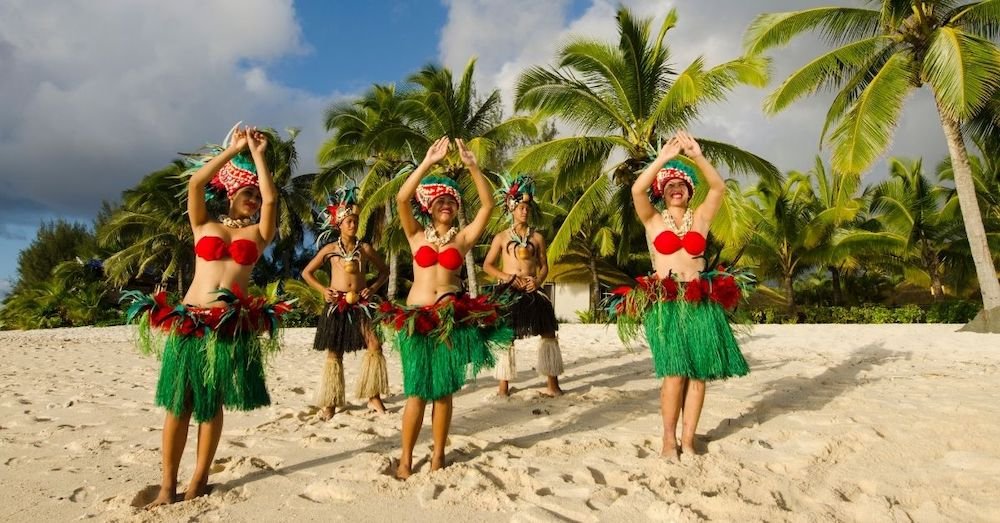
Tahitian culture is deeply rooted in Polynesian traditions and heritage, reflecting a rich tapestry of history, mythology, and artistry.
From ancient rituals to modern-day celebrations, Tahitian culture is celebrated and cherished by both locals and visitors alike.
The essence of Tahitian culture can be experienced through its music, dance, language, and cuisine, all of which play integral roles in shaping the island’s identity and spirit.
Key customs and traditions to be aware of
- Respect for Elders: In Tahitian culture, elders are revered and hold a special place of honor within the community. It is customary to show respect and deference to older individuals, whether through gestures of kindness or by following traditional protocols.
- Gift-Giving: Gift-giving is a common practice in Tahitian culture and is often used to express gratitude, respect, and friendship. When visiting someone’s home or attending a special event, it is customary to bring a small gift, such as flowers, fruit, or locally crafted items.
- Tattooing: Tattooing holds significant cultural importance in Tahitian society and is considered a sacred art form. Traditional Tahitian tattoos, known as “tatau,” feature intricate designs and symbols that convey stories, heritage, and spiritual beliefs. Tattoos are deeply respected and are often seen as symbols of strength, courage, and identity.
- Respect for Nature: The Tahitian people have a profound connection to the natural world and place great importance on preserving the environment for future generations. It is customary to show respect for nature by practicing sustainable living, participating in conservation efforts, and observing traditional beliefs and rituals that honor the land and sea.
Etiquette for interacting with locals
- Greetings: When meeting someone for the first time, it is customary to exchange a warm greeting, such as “Ia ora na” (hello) or “Maeva” (welcome). A handshake or a gentle hug is often used to express friendship and goodwill.
- Politeness: Politeness and courtesy are highly valued in Tahitian culture. It is important to use polite language, maintain a respectful demeanor, and show consideration for others at all times.
- Dress Code: While Tahiti is known for its laid-back atmosphere, it is important to dress modestly and respectfully, especially when visiting religious sites or participating in cultural events. Avoid wearing revealing clothing or attire that may be considered inappropriate in local customs.
- Learning Basic Tahitian: While English and French are widely spoken in Tahiti, learning a few basic phrases in Tahitian can go a long way in building rapport with locals and showing appreciation for their culture and language.
3. Language

Tahiti is a linguistically diverse destination, where several languages are spoken, reflecting its multicultural heritage and colonial history.
The two official languages of French Polynesia, including Tahiti, are French and Tahitian.
French serves as the primary language of administration, education, and business, while Tahitian holds significant cultural importance and is widely spoken among the local population.
In addition to French and Tahitian, English is also spoken and understood, particularly in tourist areas and among younger generations who have been exposed to English through media and education.
Visitors will find that many Tahitians are eager to communicate and interact with tourists, regardless of language barriers, and will often go out of their way to assist and accommodate them.
Basic Tahitian phrases for travelers
- Ia ora na – Hello
- Maeva – Welcome
- Mauruuru – Thank you
- Nana – Goodbye
- Aroha nui – Much love
- Fa’aitoito – Good luck
- ‘Aita pe’a-pe’a – You’re welcome
- Noa’ia’e mauruuru – Please
- Noho maeva – Sit down, please
- Manuia – Cheers!
Learning a few basic Tahitian phrases can enhance the travel experience and help visitors connect with the local culture and community.
Tahitians appreciate the effort made by visitors to learn and speak their language, and even a simple greeting or expression of gratitude can go a long way in fostering goodwill and building rapport during your stay in Tahiti.
4. Visa and Travel Requirements

For many travelers, one of the most important considerations before visiting Tahiti is understanding the visa requirements.
Fortunately, Tahiti operates under relatively lenient visa policies for many countries.
Visitors from the United States, Canada, the European Union, Australia, New Zealand, and several other countries can enter Tahiti without a visa for stays of up to 90 days for tourism purposes.
It’s essential to check the specific visa requirements based on your nationality and the purpose of your visit.
Travelers should verify visa regulations well in advance of their trip to ensure compliance and avoid any potential complications upon arrival in Tahiti.
Necessary travel documents and permits
While a visa may not be required for short-term tourism visits, travelers to Tahiti must ensure they have the necessary travel documents and permits before departure. These may include:
- Passport: All travelers to Tahiti must possess a valid passport with an expiration date that extends beyond the duration of their intended stay. It’s advisable to check your passport’s expiration date well in advance of your trip and renew it if necessary.
- Return Ticket: Immigration authorities in Tahiti may require travelers to show proof of onward or return travel, demonstrating that they intend to leave the country within the permitted visa-free period.
- Customs Declaration Form: Upon arrival in Tahiti, travelers may be required to complete a customs declaration form, declaring any items of value they are bringing into the country, including currency, electronics, and gifts.
- Travel Insurance: While not mandatory, travel insurance is highly recommended for all visitors to Tahiti. Travel insurance can provide coverage for medical emergencies, trip cancellations, lost baggage, and other unforeseen events, offering peace of mind and financial protection during your travels.
Health and vaccination recommendations
Before traveling to Tahiti, it’s important to consult with your healthcare provider or a travel medicine specialist to receive up-to-date health and vaccination recommendations.
While Tahiti is not associated with any specific health risks, travelers should be aware of the following:
- Routine Vaccinations: Ensure that your routine vaccinations, such as measles-mumps-rubella (MMR), diphtheria-tetanus-pertussis, varicella (chickenpox), polio, and influenza, are up to date before traveling to Tahiti.
- Hepatitis A and Typhoid: Vaccinations for hepatitis A and typhoid are recommended for travelers to Tahiti, particularly those planning to visit rural areas, explore local cuisine, or engage in outdoor activities.
- Mosquito-Borne Diseases: While cases of mosquito-borne diseases such as dengue fever, Zika virus, and chikungunya are rare in Tahiti, travelers should take precautions to prevent mosquito bites by using insect repellent, wearing long sleeves and pants, and staying in accommodations with screened windows and doors.
5. Currency and Money Matters

The official currency of Tahiti, as well as the wider French Polynesia, is the French Pacific Franc (XPF), abbreviated as “CFP” or “XPF” (Currency code: XPF).
The CFP franc is pegged to the Euro, with a fixed exchange rate.
While Euros are also accepted in some tourist areas and larger establishments, it’s advisable to have CFP francs for smaller purchases and transactions.
Banking facilities and ATMs availability
Banking facilities and ATMs are readily available in major towns and tourist areas throughout Tahiti.
Visitors can find ATMs operated by local banks, as well as international networks such as Visa and Mastercard.
It’s advisable to notify your bank of your travel plans before departing for Tahiti to prevent any issues with using your debit or credit cards abroad.
Most major credit cards, such as Visa and Mastercard, are widely accepted in hotels, restaurants, shops, and tourist attractions in Tahiti.
However, it’s recommended to carry some cash for smaller purchases, as well as in more remote areas where card payment facilities may be limited.
Tips for managing money while in Tahiti
- Currency Exchange: Exchange currency at authorized banks or currency exchange offices for the best rates. Avoid exchanging money at hotels or airports, as they often charge higher fees and offer less favorable exchange rates.
- Budgeting: Plan your budget carefully and consider the cost of accommodations, meals, transportation, activities, and souvenirs when estimating your expenses in Tahiti. It’s advisable to carry a mix of cash and cards for flexibility and security.
- Emergency Funds: Carry a small amount of emergency cash in a secure location, such as a money belt or hidden pocket, in case of unexpected situations where card payments may not be accepted or ATMs are unavailable.
- Tipping: Tipping is not a common practice in Tahiti, as a service charge is often included in restaurant bills. However, it’s customary to round up the bill or leave a small gratuity for exceptional service, particularly in upscale establishments or for tour guides and drivers.
- Safety Precautions: Exercise caution when withdrawing money from ATMs, especially at night or in secluded areas. Be vigilant and shield your PIN from view to prevent unauthorized access to your accounts.
6. Accommodation Options

Tahiti offers a diverse range of accommodation options to suit every traveler’s needs and preferences.
From luxurious resorts and overwater bungalows to cozy guesthouses and budget-friendly hostels, visitors can find a variety of lodging choices throughout the island.
- Luxury Resorts: Tahiti is home to numerous luxury resorts and hotels that offer world-class amenities, including private beaches, infinity pools, spa facilities, gourmet dining, and breathtaking ocean views. Many luxury resorts also feature iconic overwater bungalows, allowing guests to immerse themselves in the beauty of the surrounding lagoon.
- Boutique Hotels: Boutique hotels in Tahiti provide a more intimate and personalized experience, often showcasing local art, culture, and design elements. These smaller properties offer unique accommodations, personalized service, and a tranquil ambiance, making them ideal for couples and honeymooners seeking a romantic getaway.
- Guesthouses and B&Bs: For travelers seeking a more authentic and immersive experience, guesthouses and bed-and-breakfast establishments offer a warm welcome and personalized hospitality. These family-run accommodations provide comfortable rooms, home-cooked meals, and insider tips on exploring the local area.
- Vacation Rentals: Vacation rentals, including apartments, villas, and beachfront cottages, are popular options for families and larger groups looking for spacious and private accommodations. Vacation rentals often come equipped with kitchen facilities, living areas, and outdoor spaces, providing the comforts of home away from home.
Recommendations for different budgets and preferences
- Luxury: For travelers seeking luxury accommodations, resorts such as The St. Regis Bora Bora Resort, InterContinental Bora Bora Resort & Thalasso Spa, and Four Seasons Resort Bora Bora offer unparalleled luxury and service.
- Mid-Range: Popular mid-range options include Le Taha’a Island Resort & Spa, Sofitel Moorea Ia Ora Beach Resort, and Manava Beach Resort & Spa Moorea, which offer excellent amenities and value for money.
- Budget-Friendly: Budget-conscious travelers can consider staying at guesthouses, pensions, or backpacker hostels, such as Fare Suisse Tahiti, Moorea Surf Bed & Breakfast, and Fare D’hotes Tutehau.
Booking tips and considerations
- Book in Advance: Tahiti is a popular tourist destination, especially during peak seasons, so it’s advisable to book accommodations well in advance to secure your preferred dates and rates.
- Flexible Dates: Consider traveling during the shoulder seasons (April-May and September-October) to take advantage of lower rates and fewer crowds.
- Package Deals: Look for package deals that combine accommodation, meals, and activities to save money and simplify your travel planning process.
- Cancellation Policies: Pay attention to the cancellation policies of your chosen accommodation, especially if your travel plans are subject to change.
- Local Taxes and Fees: Be aware of any local taxes, resort fees, or service charges that may be added to your final bill at check-out.
7. Transportation
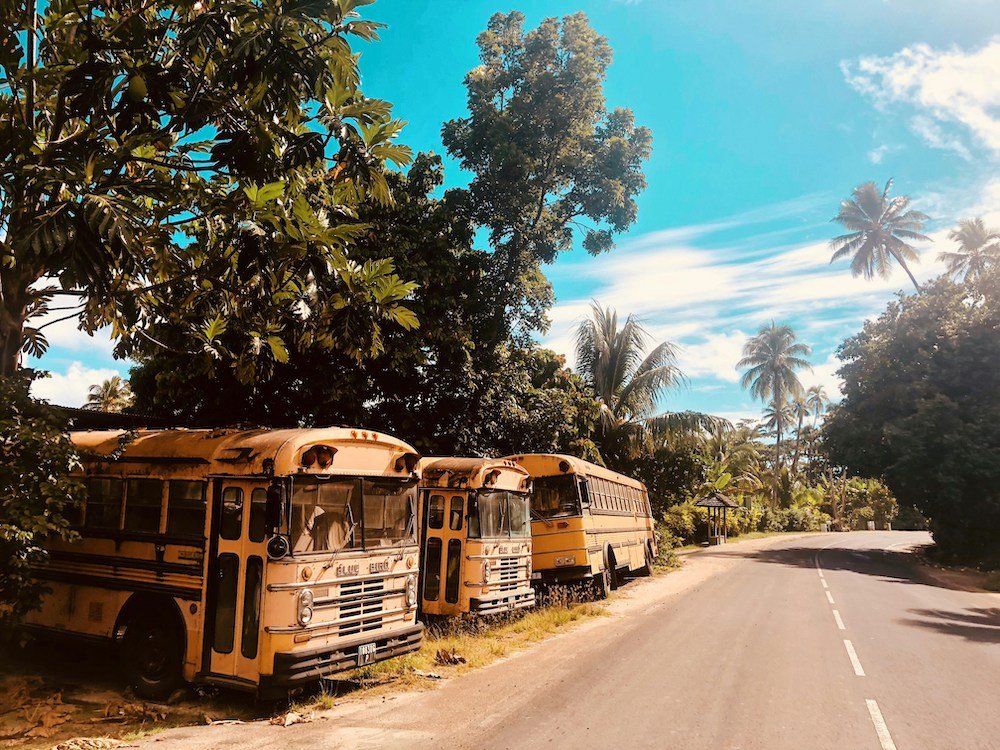
Navigating Tahiti and its surrounding islands is relatively easy, thanks to a variety of transportation options available to travelers.
From public buses and taxis to rental cars and scooters, visitors can choose the mode of transportation that best suits their preferences and itinerary.
Public transportation system
Tahiti’s public transportation system primarily consists of buses that serve major towns and tourist areas across the island.
The bus network is operated by the Office des Postes et Télécommunications (OPT), and routes are relatively comprehensive, covering most popular destinations and attractions.
While public buses provide an affordable and convenient way to get around Tahiti, they may not always be the fastest or most efficient option, especially for travelers with limited time or specific schedules.
It’s essential to check bus timetables and plan your journey accordingly, as services may be less frequent on weekends and public holidays.
Renting a car or scooter for exploring the island
Renting a car or scooter is a popular choice for travelers who wish to explore Tahiti at their own pace and discover its hidden gems off the beaten path.
Several car rental agencies operate on the island, offering a wide selection of vehicles ranging from compact cars and SUVs to jeeps and vans.
Renting a car allows travelers the flexibility to visit remote beaches, scenic viewpoints, and cultural sites at their leisure, without having to rely on public transportation schedules or taxi services.
Most major towns and airports in Tahiti have rental car offices, making it easy to pick up and drop off vehicles upon arrival and departure.
For those seeking a more adventurous mode of transportation, renting a scooter or motorcycle can be an exhilarating way to explore Tahiti’s winding coastal roads and lush interior landscapes.
Scooter rentals are available in major tourist areas and offer a fun and economical way to get around the island, especially for solo travelers and couples.
Before renting a car or scooter in Tahiti, it’s essential to familiarize yourself with local traffic laws and road conditions, as well as obtain the necessary permits and insurance coverage.
Additionally, be mindful of driving on the right side of the road, as per French regulations, and exercise caution, particularly on narrow and winding roads in rural areas.
8. Cuisine and Dining

Tahitian cuisine reflects the rich cultural heritage and abundant natural resources of the islands, blending traditional Polynesian flavors with influences from French, Chinese, and Southeast Asian culinary traditions.
Fresh seafood, tropical fruits, root vegetables, and coconut milk are staple ingredients in Tahitian dishes, creating a diverse and flavorful culinary landscape.
Must-try dishes and local specialties
- Poisson Cru: A signature Tahitian dish, poisson cru is a refreshing salad made with raw fish marinated in lime juice, coconut milk, onions, tomatoes, and cucumbers. It’s a light and flavorful dish that perfectly captures the essence of Tahitian cuisine.
- Firi Firi: These deep-fried doughnuts are a popular Tahitian treat, often enjoyed for breakfast or as a snack. Firi firi are light and airy, with a hint of sweetness, and are typically served with jam or coconut milk for dipping.
- Pua’a Roti: Pua’a roti, or roast pork, is a savory dish that features marinated pork cooked in an underground oven called an “umu.” The pork is seasoned with local herbs and spices, giving it a smoky and succulent flavor that is beloved by locals and visitors alike.
- Po’e: Po’e is a traditional Tahitian dessert made from mashed taro or banana mixed with coconut milk, sugar, and vanilla. The mixture is steamed or baked until firm and then topped with coconut cream or fruit puree, creating a decadent and satisfying treat.
Dining etiquette and restaurant recommendations
When dining in Tahiti, there are a few customs and etiquette guidelines to keep in mind:
- Respect: Tahitians place great importance on hospitality and respect for others. It’s customary to greet your hosts and fellow diners with a warm “Ia ora na” (hello) and “Mauruuru” (thank you) after the meal.
- Seating: In Tahitian culture, elders and honored guests are typically given priority seating and served first. It’s polite to wait for your host to indicate where you should sit before taking your place at the table.
- Tipping: Tipping is not expected in Tahiti, as a service charge is often included in restaurant bills. However, if you receive exceptional service, it’s appreciated to leave a small gratuity for the staff.
As for restaurant recommendations, Tahiti offers a wide range of dining options to suit every taste and budget. Some popular restaurants and eateries include:
- Le Coco’s Restaurant: Located in Papeete, Le Coco’s Restaurant is known for its exquisite French and Tahitian cuisine, elegant ambiance, and waterfront views.
- Snack Mahana: This casual beachside eatery in Moorea is famous for its fresh seafood, grilled specialties, and laid-back atmosphere. It’s the perfect spot to enjoy a delicious meal while soaking up the island vibes.
- Roulotte Food Trucks: For a taste of authentic Tahitian street food, head to one of the many roulotte food trucks scattered across the islands. These mobile eateries offer a variety of delicious dishes, from grilled fish and meat to crepes and pastries, at affordable prices.
9. Safety and Health

Tahiti is generally a safe destination for travelers, with low crime rates and a welcoming local population.
However, like any travel destination, it’s essential to be aware of potential safety hazards and take precautions to ensure a safe and enjoyable experience.
Common safety considerations for travelers in Tahiti include:
- Water Safety: While Tahiti boasts pristine beaches and crystal-clear waters, it’s important to exercise caution when swimming, snorkeling, or participating in water activities. Be mindful of strong currents, reef formations, and potential hazards such as jellyfish or sea urchins.
- Natural Hazards: Tahiti is prone to occasional natural hazards, including tropical storms, cyclones, and heavy rainfall, particularly during the wet season (November to April). Stay informed about weather conditions and heed local authorities’ advice in the event of severe weather warnings.
- Sun Protection: Tahiti experiences strong UV radiation due to its proximity to the equator. Protect yourself from sunburn and heatstroke by wearing sunscreen, sunglasses, and a hat, seeking shade during peak sun hours, and staying hydrated.
Health precautions and medical facilities availability
Prior to traveling to Tahiti, it’s advisable to consult with your healthcare provider or a travel medicine specialist to receive up-to-date health recommendations and vaccinations.
While Tahiti does not pose significant health risks for travelers, it’s important to be aware of the following:
- Mosquito-borne Diseases: While cases of mosquito-borne diseases such as dengue fever and Zika virus are rare in Tahiti, travelers should take precautions to prevent mosquito bites by using insect repellent, wearing long sleeves and pants, and sleeping under mosquito nets, especially in rural areas.
- Medical Facilities: Tahiti is equipped with modern medical facilities and hospitals, particularly in urban centers such as Papeete. However, medical care in remote areas may be limited, and travelers with pre-existing medical conditions should ensure they have adequate medication and travel insurance coverage.
Tips for staying safe while exploring Tahiti
- Stay Informed: Stay informed about local customs, traditions, and safety guidelines before and during your trip to Tahiti. Familiarize yourself with emergency contact numbers and procedures, including how to reach local authorities and medical services in case of emergencies.
- Travel with a Companion: Whenever possible, travel with a companion or in a group, especially when exploring remote or unfamiliar areas. Use reputable tour operators and transportation services, and avoid traveling alone at night or in isolated areas.
- Respect Local Customs: Show respect for Tahitian culture and traditions by dressing modestly, adhering to local customs and etiquette, and seeking permission before photographing or entering sacred sites.
- Secure Your Belongings: Keep your belongings secure and valuables out of sight, particularly in crowded areas and tourist hotspots. Use hotel safes or secure lockers to store important documents, passports, and cash while exploring Tahiti.
10. Activities and Attractions

Tahiti offers a plethora of activities and attractions that cater to every traveler’s interests and preferences.
From exploring pristine beaches and lush rainforests to immersing yourself in vibrant cultural experiences, there’s something for everyone to enjoy in this tropical paradise.
Some popular activities and attractions in Tahiti include:
- Matira Beach: Located on the island of Bora Bora, Matira Beach is renowned for its powdery white sands, turquoise waters, and stunning sunsets. It’s the perfect spot for swimming, snorkeling, and sunbathing against the backdrop of Mount Otemanu.
- Belvedere Lookout: Situated in the heart of Moorea, the Belvedere Lookout offers panoramic views of Cook’s Bay and Opunohu Bay, framed by lush green valleys and towering peaks. It’s a popular spot for hiking, photography, and enjoying the natural beauty of the island.
- Water Activities: Tahiti’s crystal-clear waters are a playground for water enthusiasts, offering a wide range of activities such as snorkeling, scuba diving, paddleboarding, kayaking, and jet skiing. Explore colorful coral reefs, swim with sharks and rays, or embark on a sunset cruise to experience the magic of the South Pacific.
B. Adventure sports and outdoor experiences
For adrenaline junkies and outdoor enthusiasts, Tahiti offers a host of thrilling adventure sports and outdoor experiences that showcase the island’s rugged terrain and natural beauty.
Some adventure sports and outdoor experiences to enjoy in Tahiti include:
- Hiking: Lace up your hiking boots and explore Tahiti’s lush interior landscapes on foot. From scenic trails and mountain peaks to hidden waterfalls and ancient archaeological sites, there’s no shortage of hiking opportunities for all skill levels.
- Surfing: Tahiti is world-renowned for its epic surf breaks, including the legendary waves of Teahupo’o. Whether you’re a seasoned pro or a novice surfer, you can catch some of the best waves in the world and experience the thrill of riding the Pacific swells.
- ATV Tours: Embark on an exhilarating ATV tour and explore Tahiti’s rugged terrain, volcanic craters, and remote valleys. Ride through lush forests, cross mountain streams, and discover hidden treasures off the beaten path on an adrenaline-fueled adventure.
Cultural events and festivals to attend
Immerse yourself in Tahitian culture and traditions by attending one of the many cultural events and festivals held throughout the year.
From traditional dance performances and music concerts to culinary festivals and artisan markets, there’s always something happening in Tahiti to delight and inspire visitors.
Some cultural events and festivals to attend in Tahiti include:
- Heiva i Tahiti: Held annually in July, Heiva i Tahiti is the island’s most celebrated cultural festival, featuring traditional dance competitions, music performances, sporting events, and artisan exhibitions. It’s a vibrant celebration of Tahitian culture and heritage that attracts visitors from around the world.
- Tahiti Pearl Regatta: The Tahiti Pearl Regatta is a premier sailing event that takes place each year in May, bringing together sailors and yachting enthusiasts from across the globe. Enjoy thrilling races, lively parties, and cultural festivities against the backdrop of Tahiti’s stunning lagoons and islands.
- Vanilla Festival: Held in Taha’a, known as the “Vanilla Island,” the Vanilla Festival celebrates the island’s rich vanilla heritage with guided tours of vanilla plantations, tastings of vanilla-infused dishes and desserts, and cultural performances showcasing the importance of vanilla in Tahitian cuisine and culture.
11. Environmental Considerations
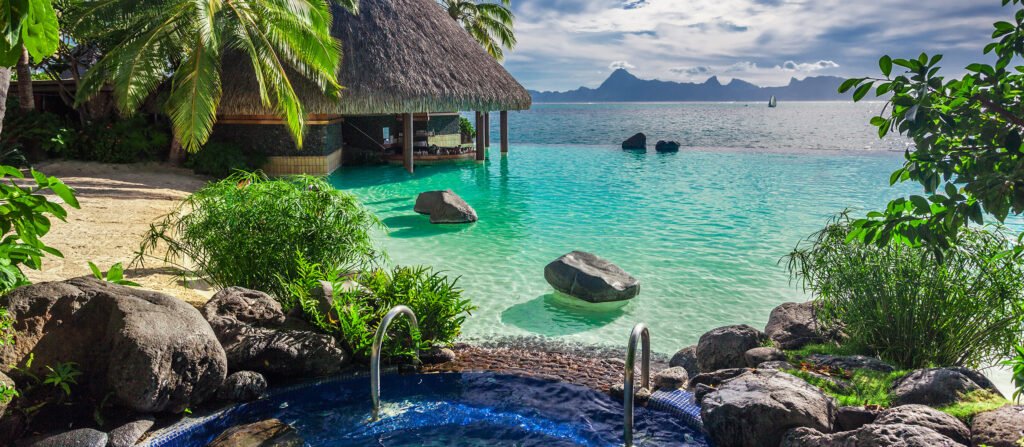
Tahiti’s natural environment is a precious and fragile ecosystem that plays a vital role in sustaining the island’s biodiversity, cultural heritage, and way of life.
From pristine coral reefs and lush rainforests to crystal-clear lagoons and endemic wildlife, Tahiti’s natural beauty is a source of wonder and inspiration for visitors and locals alike.
Preserving Tahiti’s natural environment is essential for maintaining ecological balance, protecting endangered species, and ensuring the long-term sustainability of the island’s ecosystems.
The health of Tahiti’s environment is closely linked to the well-being of its people, economy, and future generations, making conservation efforts a top priority for residents, businesses, and policymakers.
Responsible tourism practices
As stewards of Tahiti’s natural environment, travelers have a responsibility to practice sustainable and responsible tourism behaviors that minimize their impact on the delicate ecosystems and cultural heritage of the islands. Responsible tourism practices in Tahiti include:
- Respecting Wildlife: Avoid disturbing or feeding wildlife, including marine animals such as sharks, rays, and sea turtles. Keep a safe distance from nesting birds and refrain from touching or handling coral reefs and marine life while snorkeling or diving.
- Reducing Waste: Dispose of trash properly and recycle whenever possible. Bring reusable water bottles, shopping bags, and containers to minimize single-use plastics and reduce waste generation during your travels.
- Conserving Water: Be mindful of water consumption and take shorter showers, turn off taps when not in use, and report any leaks or water wastage to hotel staff. Conserve water resources to help preserve Tahiti’s freshwater ecosystems and support sustainable water management practices.
- Supporting Local Conservation Efforts: Contribute to local conservation projects, marine protected areas, and environmental initiatives that promote the preservation of Tahiti’s natural resources and cultural heritage. Participate in beach clean-up events, tree planting activities, and educational programs to make a positive impact on the community and environment.
Tips for minimizing environmental impact while visiting Tahiti
- Choose eco-friendly accommodations: Stay at hotels, resorts, and guesthouses that prioritize sustainability, energy efficiency, and environmental conservation practices. Look for eco-certifications and green initiatives such as solar power, water conservation measures, and waste recycling programs.
- Explore responsibly: Respect local customs, traditions, and natural environments when exploring Tahiti’s landscapes and attractions. Stay on designated trails, follow signage and guidelines at protected areas, and avoid removing or damaging plants, rocks, or artifacts.
- Conserve energy: Conserve energy by turning off lights, air conditioning, and electronics when not in use. Opt for energy-efficient transportation options such as walking, cycling, or using public transportation to reduce carbon emissions and air pollution.
- Support sustainable tourism operators: Choose tour operators, restaurants, and businesses that prioritize sustainable practices, ethical sourcing, and community engagement. Seek out eco-friendly tours and activities that promote environmental education, conservation, and cultural exchange.
12. Communication and Connectivity

Tahiti offers relatively good connectivity in terms of internet and mobile networks, especially in urban areas and popular tourist destinations.
Most hotels, resorts, restaurants, and cafes provide Wi-Fi access to guests, allowing travelers to stay connected and access the internet for communication, navigation, and entertainment purposes.
As for mobile networks, Tahiti is served by several telecommunications providers, including Vodafone, Digicel, and VINI, offering comprehensive coverage across the islands.
Travelers can purchase prepaid SIM cards or data plans from local stores and kiosks to access mobile data and make phone calls during their stay in Tahiti.
Tips for staying connected while in Tahiti
- Purchase a local SIM card: Consider purchasing a local SIM card upon arrival in Tahiti to access mobile data and make local calls at affordable rates. SIM cards can be easily obtained from telecommunications providers and convenience stores throughout the island.
- Use Wi-Fi hotspots: Take advantage of free Wi-Fi hotspots available at hotels, cafes, restaurants, and public areas to stay connected without incurring additional data charges. Many establishments offer complimentary Wi-Fi access to patrons, allowing travelers to browse the web and check emails on the go.
- Download offline maps: Download offline maps and navigation apps such as Google Maps or Maps.me before arriving in Tahiti to navigate the island’s roads and attractions without relying on mobile data. Offline maps can be particularly useful for exploring remote areas and hiking trails where internet connectivity may be limited.
Communication options for international travelers
For international travelers visiting Tahiti, there are several communication options available to stay connected with friends, family, and colleagues back home:
- International roaming: Check with your mobile carrier about international roaming options and rates for using your phone and data plan abroad. Keep in mind that international roaming charges can be expensive, so consider activating a travel plan or purchasing a local SIM card for more affordable rates.
- VoIP and messaging apps: Use Voice over Internet Protocol (VoIP) apps such as WhatsApp, Skype, and Viber to make free or low-cost calls and send messages over Wi-Fi or mobile data. VoIP apps are convenient and cost-effective alternatives to traditional phone calls, especially for international communication.
- Email and social media: Stay connected with loved ones and share your travel experiences through email, social media platforms such as Facebook, Instagram, and Twitter. Post updates, photos, and videos of your adventures in Tahiti to stay connected with friends and followers around the world.
Conclusion
Visiting Tahiti promises an unforgettable experience filled with natural beauty, cultural richness, and adventure.
Throughout this guide, we’ve explored essential aspects to consider before embarking on your journey to this enchanting island paradise.
From its stunning beaches and lush landscapes to its vibrant culture and delectable cuisine, Tahiti offers a myriad of attractions and activities for travelers of all interests and preferences.
Understanding the geography, climate, language, and customs of Tahiti enhances your appreciation and enjoyment of this unique destination.
As you embark on your adventure to Tahiti, embrace the spirit of exploration and discovery that defines this tropical paradise.
Immerse yourself in the beauty of its turquoise lagoons, embark on thrilling outdoor adventures, savor the flavors of Tahitian cuisine, and connect with the warmth and hospitality of its people.
Take time to wander off the beaten path, engage with local communities, and create memories that will last a lifetime.
Whether you’re seeking relaxation, adventure, or cultural immersion, Tahiti offers endless possibilities for discovery and enrichment.
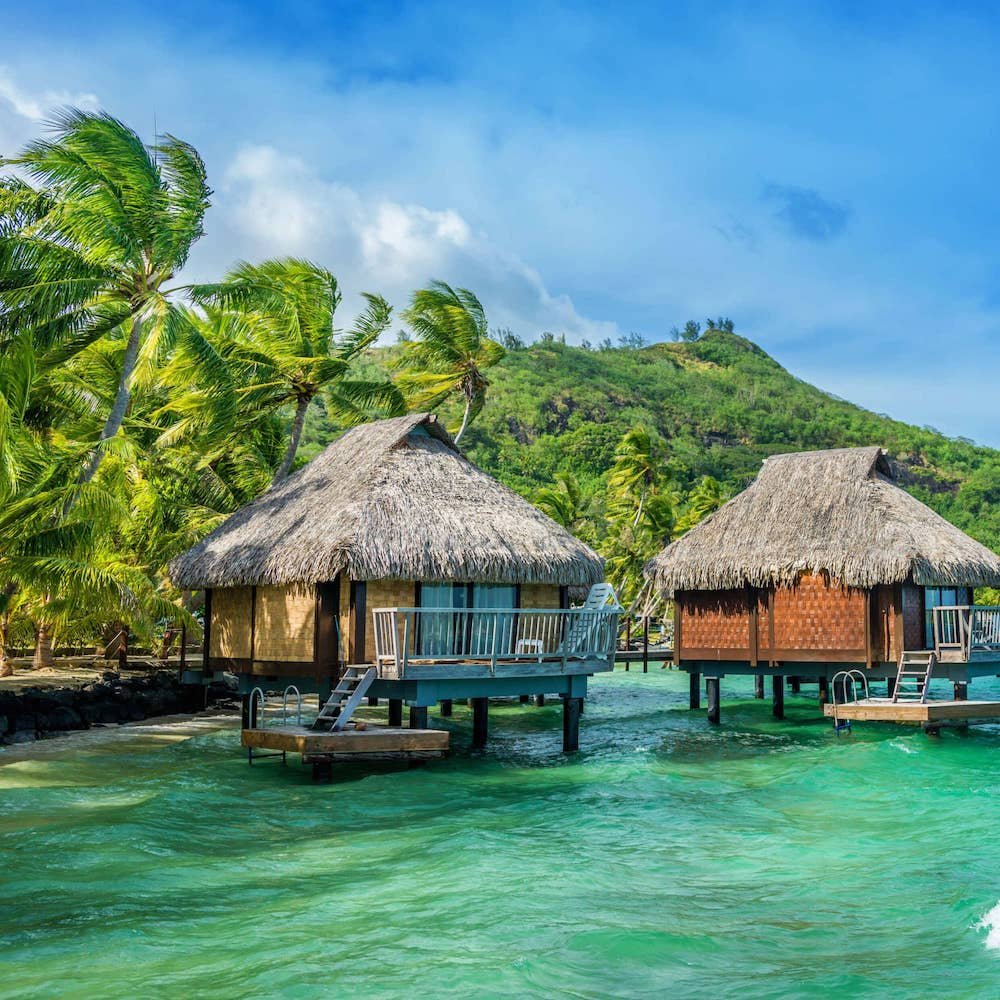
FAQ’s About the Island of Tahiti:
Is Tahiti very expensive?
Tahiti can be considered relatively expensive compared to many other travel destinations.
The cost of accommodation, dining, and activities in Tahiti tends to be higher due to its remote location and popularity as a tourist destination.
However, there are options available for travelers with various budgets, and careful planning can help mitigate expenses.
Is Tahiti closer to Hawaii or Australia?
Tahiti is closer to Hawaii than Australia.
While Tahiti is located in the South Pacific Ocean, approximately 4,000 kilometers southwest of Hawaii, it is much farther from Australia, which is located to the southwest of Tahiti, across the Tasman Sea.
Which is better Bora Bora or Tahiti?
The comparison between Bora Bora and Tahiti depends on individual preferences and travel objectives.
Tahiti is the largest island in French Polynesia and offers diverse experiences, including cultural attractions, lush landscapes, and vibrant markets.
Bora Bora, on the other hand, is renowned for its iconic overwater bungalows, crystal-clear lagoon, and romantic ambiance.
Both destinations have their unique charms, and the choice between them ultimately depends on the traveler’s preferences.
What country does Tahiti belong to?
Tahiti is part of French Polynesia, which is an overseas collectivity of France.
French Polynesia consists of 118 islands and atolls, with Tahiti being the most populous and well-known island in the archipelago.
Is Fiji more expensive than Tahiti?
In general, Fiji is considered to be more affordable than Tahiti in terms of accommodation, dining, and activities.
While both destinations offer stunning natural beauty and a range of tourism experiences, Fiji tends to have more budget-friendly options for travelers, making it a popular choice for those seeking a tropical getaway without breaking the bank.
Is Tahiti expensive for Australians?
Tahiti can be relatively expensive for Australians due to factors such as distance, exchange rates, and the cost of living in French Polynesia.
However, Australians who plan their trip thoughtfully, research affordable accommodation and transportation options, and take advantage of travel deals and packages can still enjoy a memorable and rewarding experience in Tahiti.
How far is the flight from Australia to Tahiti?
The distance between Australia and Tahiti varies depending on the departure city in Australia and the destination airport in Tahiti.
On average, direct flights from major Australian cities such as Sydney or Melbourne to Tahiti’s capital, Papeete, take approximately 8 to 9 hours.
How safe is Tahiti for travel?
Tahiti is generally considered safe for travel, with low crime rates and a welcoming local population.
Like any destination, travelers should exercise caution and remain vigilant, particularly in crowded areas, tourist hotspots, and at night.
It’s advisable to take common-sense safety precautions, such as safeguarding valuables, avoiding isolated areas after dark, and staying informed about local customs and regulations.
Are there direct flights from Australia to Tahiti?
Yes, there are direct flights from Australia to Tahiti.
Several airlines, including Air Tahiti Nui and Qantas, operate direct flights from major Australian cities such as Sydney and Melbourne to Tahiti’s Faa’a International Airport in Papeete.
These flights offer convenient options for travelers seeking direct access to Tahiti from Australia.
